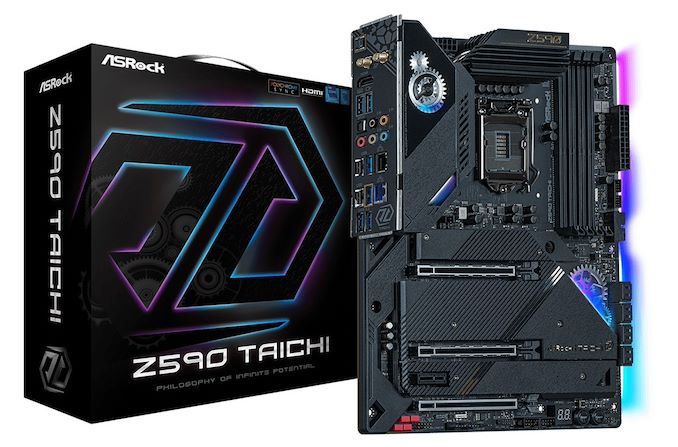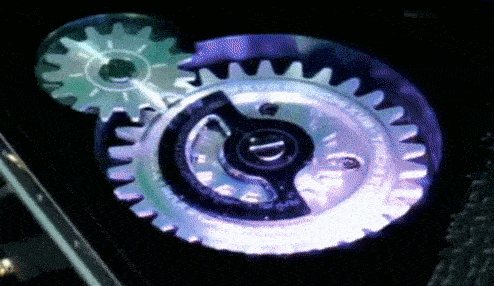ASRock Z590 Taichi Review: An Intel Motherboard with Moving Parts (and Thunderbolt 4)
by Gavin Bonshor on April 1, 2021 11:00 AM ESTConclusion
While the onus is still out there whether or not Intel's 11th gen Rocket Lake processors represent a worthwhile purchase over its Comet Lake options, we know the Z590 chipset is superior to the Z490 chipset in many ways. It's all good and well Intel implementing lots of new features if motherboard vendors aren't going to capitalize on it. It seems as ASRock has done just that as the Z590 Taichi ticks a lot of boxes and uses multiple elements of the new design, with PCIe 4.0 support with Rocket Lake's processors, as well as networking improvements and overall design implementations.
One of the more unique additions to the Taichi design is a rotating cogwheel located in the rear panel cover. This can be customized in the firmware, and it provides a nice visual look. It operates via an internal stepping motor, and we didn't observe this to produce any unsavory noise. Compared to the ASRock Z490 Taichi, the new Z590 Taichi is using an all-black aesthetic with PCIe slot armor which looks clean and is more compatible with other components than other unconventional color schemes we've seen over the years. The Taichi also has plenty of integrated and customizable RGB LEDs to play around with.
With a more generalized approach than its gaming-focused models, the ASRock Z590 Taichi looks to cater to many different market segments including enthusiasts, gaming, content creator, and the general user. There's no denying that the power delivery is highly capable of overclocking, while content creators and professionals will appreciate the dual Thunderbolt 4 Type-C connectivity on the rear panel. Other notable features include triple PCIe M.2, with one fast PCIe 4.0 x4 M.2 slot and two supporting PCIe 3.0 and SATA drives, with eight SATA ports in total. There is some bandwidth sharing going on between the M.2 slots and SATA ports which is commonplace, but the more expensive NVMe PCIe storage drives ultimately offer better storage performance.
Other connectivity options on the rear panel include two USB 3.2 G2 Type-A, and four USB 3.2 G1 Type-A, with plenty of extra ports made available through the use of front panel headers. This also includes a single USB 3.2 G2x2 Type-C header which is now natively supported by the Z590 chipset. Also present is a BIOS Flashback button which is handy for updating the board's firmware at a press of a button, although it's still relatively easy to do with the UEFI firmware. The audio array is also premium with a Realtek ALC1220 HD audio codec and ESS Sabre 9218 DAC providing superior support for high impedance headphones, which are presented via five 3.5 mm audio jacks and S/PDIF optical output. For networking, the Z590 Taichi includes one Killer E3100G 2.5 GbE controller, with a secondary RJ45 port powered by an Intel I219-V Gigabit controller. The board's wireless capabilities come from an Intel-based Killer AX1675x Wi-Fi 6E CNVi.
In our performance testing and comparing the Taichi against other Z590 models we've tested so far, we saw really competitive performance in both compute and gaming benchmarks. In our system tests, the ASRock Z590 Taichi performed well with a respectable result in our DPC latency testing, although we did see higher than normal POST times and power. The Windows 10 operating system is quite a fast boot OS compared to previous versions, and we were disappointed with POST times on the Taichi. We expect this to be rectified as the firmware matures.
When performing our overclock testing, we did see pretty aggressive levels of VDroop when comparing defined voltage in the firmware to what we experienced at load. When under an aggressive load for a sustained period of time, we observed good thermal performance from the board's actively cooled power delivery heatsink, and ASRock does include an additional 3 cm fan and mounting brackets to further enhance the cooling properties.
Final Thoughts
The ASRock Z590 Taichi is available at Newegg (at the time of writing) for $430 which is a very good price considering all of the board's available features. It has a subtle and clean design, with plenty of user-customizable elements such as RGB LEDs and the new moving cogwheel which adds a new dimension to motherboards in general. We highlighted in our previous Z490 Taichi review that more metal instead of plastic could be used, and despite the rear panel cover remaining plastic, the PCIe slot armor is now metal and has a more overall premium feel to it.
The ASRock Z590 Taichi despite its high price tag offers lots of premium features such as Thunderbolt 4, 2.5 GbE networking, and the new Wi-Fi 6E CNVi. This makes it a very attractive model to users looking for a comprehensive and usable package, without paying the price of a $1000 flagship.












50 Comments
View All Comments
Cullinaire - Thursday, April 1, 2021 - link
What a gimmick. Instead of a stepper motor why not have a steam engine powered by the CPU heat.Molor1880 - Thursday, April 1, 2021 - link
Should have gone with a tiny sterling engine. That would make this joke a bit better.kachan64 - Friday, April 2, 2021 - link
Agree. Should have gone with that!YB1064 - Friday, April 2, 2021 - link
No 10GbE on a FOUR HUNDRED dollar motherboard?? No thanks.zanon - Saturday, April 3, 2021 - link
This, the money they put into the gimmick useless juno should have gone to networking instead. Though I suppose in fairness unlike AMD they have to work with severe bandwidth limitations so they can't just do every single useful feature. But that one should have been a priority.ZoZo - Saturday, April 3, 2021 - link
There's the same bandwidth on the Z590 platform as the X570.20 PCI-E 4.0 lanes from the CPU, and ~4 GB/s between CPU and chipset (through 4 PCI-E 4.0 lanes on X570, and 8 DMI/PCI-E 3.0 lanes on Z590).
And 10 Gb/s networking just needs 1.25 GB/s, so no severe bandwidth limitations from connecting it to a PCI-E 3.0 x1 link to the chipset.
TheinsanegamerN - Sunday, April 4, 2021 - link
The raichu line had 10gb as a selling point with the z200 and x400 vhipsets. For some reason asrock abandoned this idea and raised the price.TheinsanegamerN - Sunday, April 4, 2021 - link
Agreed. The whole reason to get a taichi was the 10gb ethernet onboard.Samus - Saturday, April 3, 2021 - link
This is about the level of gimmick I expected from ASRock, after all the brand is a second-rate Asus so they need to do these cheesy things to get attention.zotric - Sunday, October 10, 2021 - link
I must say I have had excellent support for my older ASRock Taichi board so don't write it off!